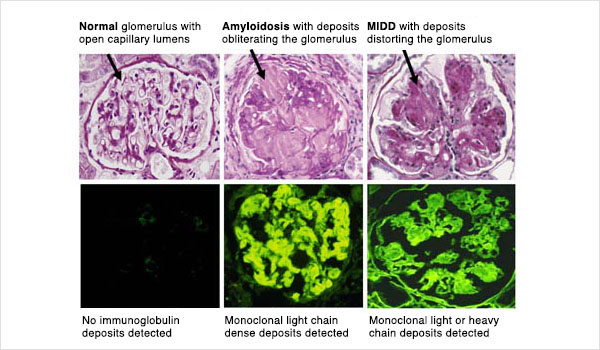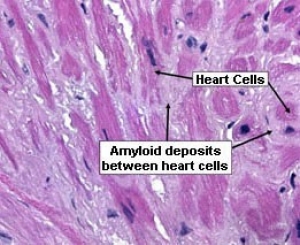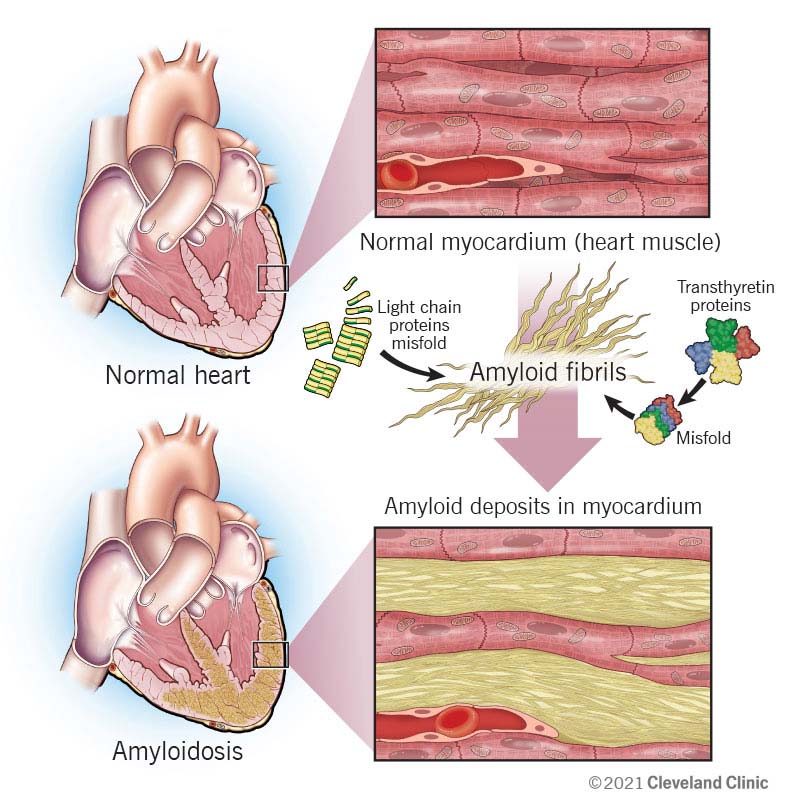Amyloid Deposits Form in Which of the Following Cancers
Gastrointestinal Amyloidosis may cause nausea diarrhea or constipation abdominal pain and bloating. The symptoms of amyloidosis can vary widely depending on the specific organ or number of organs affected by the buildup of amyloid protein.

Al Amyloidosis Unc Kidney Center
Localized amyloid deposits which were not defined as CA have been also described in prostate seminal vesicles and in the lower urinary tract in some case studies on human patients by using clinical radiological MRI and immunohistopathological techniques.

. Systemic means that the deposits may be found throughout the body. Pathological diagnosis before surgery is important to avoid excessive invasion. An amyloid tumor of the breast may show findings suggestive of breast cancer.
Amyloid deposits may occasionally occur in isolation without evidence of a systemic disease. This cancer is a mix between multiple myeloma and B-cell lymphoma the cells look and act like both plasma cells and B cells. In the human body amyloids have been linked to the development of various diseases.
Dialysis-related beta2-microglobulin amyloidosis is a type of systemic amyloidosis that can occur in individuals who have experienced long-term kidney dialysis to remove accumulated impurities. Amyloid pro precursor genes in response to various etiologic factors produce a circulating or local amyloid precursor poolTogether with normal tissue components this pool forms soluble amyloid oligomersCo-precipitation of SAP and inorganic ions consolidate the oligomers into amyloid deposits. AL amyloidosis is closely related to a type of bone marrow cancer called myeloma or multiple myeloma another disease in which identical clones of antibody-producing cells grow rapidly.
Gastrointestinal Amyloidosis is generally associated with AA AL hereditary and dialysis-related subtypes of amyloidosis. Aβ levels have been assessed in relation to a number of cancers including esophageal colorectal lung and hepatic in response to observed reductions in risk for developing Alzheimers disease in survivors of these cancers. AL amyloidosis can occur with a bone marrow cancer of plasma cells called multiple myeloma fewer than 20 of AL patients.
Some people with AL amyloidosis also have cancer of the plasma cells multiple myeloma. Most types of the condition are more likely to occur in men and in older adults. These abnormally configured proteins are thought to play a central role in Alzheimers disease.
Although it is not a type of cancer it may be associated with certain blood cancers like multiple myeloma. In this condition the amyloid deposits mainly affect the heart and can also cause carpal tunnel syndrome in some people. The symptoms of wild-type ATTR amyloidosis usually only appear after around the age of 65.
Systemic amyloidosis is the most common. Hereditary ATTR amyloidosis may cause symptoms at any age from about 30 years old. Encephalopathy in which an inflammatory response occurs against Aβ deposit in CAA-affected.
Amyloids are aggregates of proteins characterised by a fibrillar morphology of 713 nm in diameter a beta sheet secondary structure and ability to be stained by particular dyes such as Congo red. If deposits of nonstructural substances are observed by hematoxylin and eosin staining Congo red staining should be added. A symptom is something that only the person experiencing it can identify and describe such as fatigue nausea or pain.
Amyloid deposits can affect the nerves of the hands feet and lower legs and may cause pain numbness and tingling. People with AL amyloidosis and non-Hodgkin lymphoma tend to have amyloid deposits in the lymph nodes and in the lungs. All cancers were shown to be associated positively with increased Aβ levels particularly hepatic cancers.
Amyloid plaques are aggregates of misfolded proteins that form in the spaces between nerve cells. Pathogenic amyloids form when previously healthy proteins lose their normal structure and. The deposits collect in organs and tissues and may lead to organ damage and health problems including kidney disease.
The condition usually occurs in older men and women with men being more susceptible to the condition than women. In multiple myeloma the main problem is the growth of abnormal cells in the bone marrow. Amyloid deposits in the digestive system can cause nausea diarrhea or constipation weight loss loss of appetite or a feeling of fullness in the stomach after eating small amounts.
Amyloidosis affects 15 of patients with a. Many different proteins can lead to amyloid deposits but only a few have been linked to major health problems. The amyloid build-up primarily affects the kidneys and nerves Wild-type ATTR amyloidosis.
Are diagnosed each year with AL amyloidosis the most common type of amyloidosis. It is an inherited form of the disease. About 4500 people in the US.
AL amyloidosis including multiple myeloma cancer is not associated with any other diseases but is a disease entity of its own conventionally requiring chemotherapy treatment. People often have bone pain. Cerebral amyloid angiopathy-related inflammation CAA-ri is a rare autoimmune.
This form leads to amyloid protein deposits in elderly adults particularly in the heart and tendons. Many parts of the body can be affected by the symptoms of amyloidosis. People with amyloidosis may experience the following symptoms or signs.
In AL primary amyloidosis the main problem is the build up of light chains produced by the. AL amyloidosis can also occur with Hodgkin lymphoma. Amyloidosis is caused by an abnormal folding of proteins.
Amyloid protein deposits can be found in specific organs such as the lung skin bladder or bowel or they can be systemic. Amyloidosis is a rare disorder. Multiple Myeloma Multiple myeloma is a cancer of plasma cells in which abnormal plasma cells multiply uncontrollably in the bone marrow and occasionally in other parts of the body.
These proteins can clump together and form amyloid deposits. Experts have identified more than 30 different proteins that can form amyloid. Isolated bladder or tracheal amyloidosis are the most common such presentations.
Amyloidosis is a rare disease that is underdiagnosed.

Al Primary Amyloidosis Stanford Health Care

Comments
Post a Comment